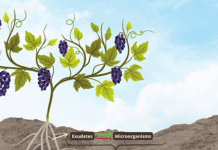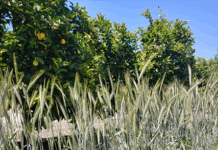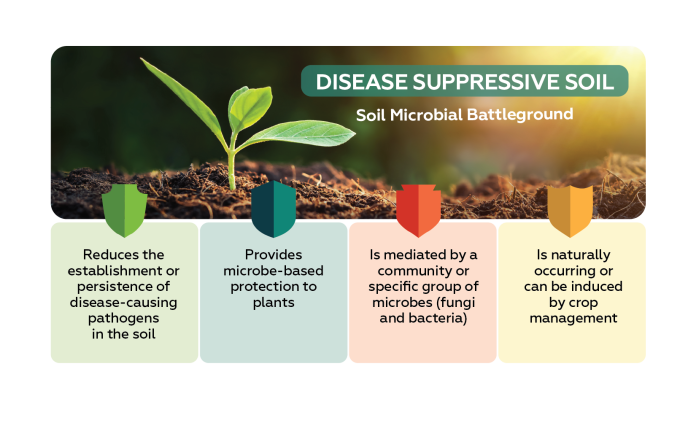
When it comes to managing soilborne plant diseases, methods for reducing or eliminating the impact of pathogens have heavily relied on selecting a resistant plant variety and the use of pesticides for protection. However, the soil, and specifically the biological component consisting of microbes, can be another tool growers can leverage to help protect their crops from soilborne diseases.
Healthy soil and a healthy crop can lead to reduced disease incidence, an idea that is becoming more widely accepted across the agriculture industry. Many questions arise with this concept: How are soil health and soilborne plant diseases related? Can soil health result in less plant disease increase pressure? What are the mechanisms behind this phenomenon? In this article, we will discuss and address these questions and take a deep dive into a phenomenon known as disease suppressive soil (DSS).
Microbes Are the Key
The activity of soil microbes or communities of microbes is what gives rise to a soil’s disease suppressive properties. As you can imagine, the soil is a complex system, and understanding the mechanisms that contribute to DSS is extremely intricate. Imagine the interactions between beneficial and pathogenic microbes as a battlefield belowground. In the case of DSS, the beneficial microbes win. Just like on a battlefield, many tactics, strategies and tools are needed to overcome your opponent; and the same is true for soil microbes. Multiple mechanisms from increasing soil and plant health to directly impacting pathogenic microbes are used by soil microbes in the battle between beneficial and pathogenic.
Soil microbes play a key role in soil health and soil quality, which in return affect the degree of disease suppression in the soil. Soil microbes have multiple ways in which they suppress disease in the soil, including the improvement of plant health, inducing natural defense response in the host plant, secreting enzymes and antibiotics, and through microbial competition.
Defining Suppressive Soils and Why They Matter
DSS are defined as soils that naturally defend against pathogenic diseases before the disease attacks a growing crop, or the pathogen can infect the crop but the disease declines with successive cropping (Figure 1). Soils can do this through reducing the establishment or growth of pathogenic fungi or bacteria due to the makeup of their microbiome (the communities of fungi and bacteria that are living in the soil.) Soils can keep disease development at a minimum even in the presence of a susceptible host and disease-causing pathogen.
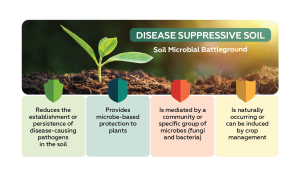
DSS can be naturally occurring but may also be developed over time through cropping practices. To help clarify, we can divide suppressive soils into two categories: general suppression and specific suppression (Figure 2).
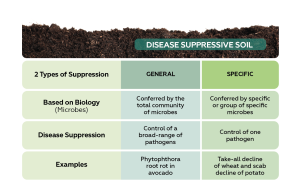
General suppression gives protection towards multiple pathogenic microbes. The increase in the abundance (number of microbes) and diversity (which microbes are present) of soil microbes is key in general suppression. These soil microbes out-compete pathogenic microbes, which in turn creates general suppression. Agricultural practices can impact this type of suppression with practices such as soil sterilization reducing it and good soil health practices enhancing it.
Specific suppression can occur naturally (long-standing) or be induced. Long-standing specific suppression is associated with a specific species of microbes or group of microbes and is naturally found in the soil without the presence of a plant. Induced specific suppression can be produced through monoculture of a crop, growing susceptible crops or by mixing small amounts of a suppressive soil into a conducive soil.
So, why should we care about DSS? As we move forward in modern agriculture, restriction of fumigants and pesticides as well as the lack of available resistant cultivars will only make these soilborne diseases harder to manage. DSS are another tool growers can use to help manage difficult-to-control soilborne diseases.
Soil Microbial Battleground
Beneficial soil microbes have a direct impact on their pathogenic counterparts, but on the battlefield, the beneficial soil microbes can outcompete their pathogenic counterparts, leading to greater numbers of beneficial soil microbes. Underground, beneficial soil microbes use up the exudates and nutrients created and released by the host plant, blocking the pathogenic microbes from accessing and utilizing the resources needed to survive.
During the battle, the soil microbes can display hyperparasitism, where they infect pathogenic microbes present in the soil that pose a threat to the crops around them. Plus, the microbes can cause additional impact on their pathogenic microbial counterparts by secreting antibiotic-like enzymes and toxins in a process called antibiosis. Antibiosis is a competitive tactic that kills other pathogenic microbes and increases their ability to battle and defend themselves and the host plant from pathogens.
The health of the host plant above the ground is impacted by the soil health under the ground. The structure of the soil plays a direct role in plant health in terms of water infiltration, retention, soil compaction and access to nutrients. Soil microbes are to key to improving soil structure through increased soil aggregation, and aid in the release of mineral nutrients through a conversion process called nutrient mineralization. Soil microbes secrete exudates that can trigger disease-resistant responses for host plants. All these factors aid in improved plant health and performance.
Soil Health Impact
In the soil microbe-pathogen battleground, what exactly are these microbes battling for? For the pathogenic microbes, they are battling to infect the host plant. To understand the complexity and how soil health and microbes play a role in plant disease and DSS, we need to review the disease triangle (Figure 3). For disease to occur, there must be three components (representative of the sides of a triangle):
Susceptible host
Conducive environment
Virulent pathogen
If one of these sides is removed, plant disease is not possible. The environment side of the triangle is where we need to focus as this is the side that includes soil health and holds the key to creating disease suppressive soils.
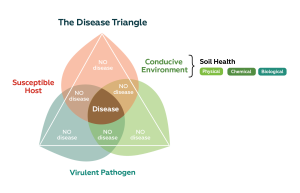
The physical and chemical properties of the soil, including pH, soil organic carbon and nutrients, provide the habitat for microbial activity. Crop management practices such as tillage, irrigation, fertilization, the addition of green manures and weed management can directly impact the soil environment and microbial activity in the soil. Many of the factors mentioned here directly impact microbial activity and communities and are the key to soil health. Many of the factors mentioned here directly impact microbial activity and communities and are the key to soil health. As we know, there are tools and inputs to help improve soil health, meaning that if we manipulate the environment (the soil) and remove one side of the disease triangle, we can reduce plant disease infection. Therefore, improving soil health can lead to general DSS (Figure 4).
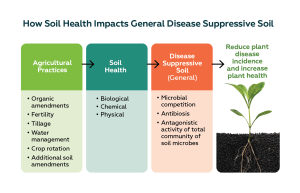
What about specific disease suppression? If we recall, long-term monocropping can be used to achieve specific suppression in some systems, which is contradictive of soil health practices. The literature has noted the ability to achieve specific disease suppression by using compost and green manures. However, increasing soil health and increasing microbial communities is the best practice to achieve and improve general suppression and increase crop productivity.
Managing the Soil to Achieve Disease Suppressive Soil
Soil microbes are key to DSS, and soil health directly impacts the makeup and activity of soil microbes. DSS can be negatively or positively impacted by cropping systems and management practices. Soil management practices that positively influence DSS include crop rotation, intercropping, minimum tillage practices, fertility or organic inputs such as manures and composts. In addition, adding liable carbon sources as a food source for microbes will increase the abundance and diversity of soil microbes, which is critical in general suppression. Crop rotation is an important factor; rotating to a non-host can aid in reducing soilborne diseases and positively impact soil microbial diversity. What we know to date is that suppressive soils are usually mediated through soil microbial community shifts overtime, so adopting practices and amendments that increase soil health and organic matter and increase the diversity and abundance of microbial activity in your soils will aid in suppressing soilborne diseases.
Battle for a Sustainable Solution to Soilborne Diseases
DSS can be a tool for soilborne disease management. Adapting soil health practices and increasing the soil microbial activity is a sustainable agricultural practice that will be key in the coming years. Building and maintaining suppressive soils can provide a solid foundation for crops to thrive. We’ve discussed the key to DSS (microbes) and contribution to a soil’s disease suppressive properties. Focusing on the improvement of soil health and natural defense response belowground is a good first step toward the achievement of healthy crops that are protected against soilborne disease.
Resources
Disease Suppressive Soils: New Insights from the Soil Microbiome- https://doi.org/10.1094/PHYTO-03-17-0111-RVW
Disease-Suppressive Soils—Beyond Food Production: a Critical Review- https://www.ncbi.nlm.nih.gov/pmc/articles/PMC7953945/
Current Insights into the Role of Rhizosphere Bacteria in Disease Suppressive Soils- https://doi.org/10.3389/fmicb.2017.02529
Plant Health Management: Pathogen Suppressive Soils- https://doi.org/10.1016/B978-0-444-52512-3.00182-0
Fine-Tuning with Soil Health; Soilborne Disease?- https://csanr.wsu.edu/fine-tuning-soilborne-disease/
Developing Disease-Suppressive Soil Through Agronomic Management- https://www.researchgate.net/publication/292011599_Developing_Disease-Suppressive_Soil_Through_Agronomic_Management






